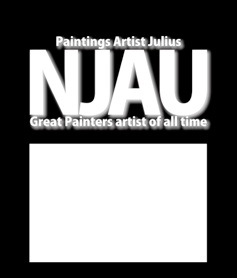
Julius Njau was born in 1961 in Marangu, Moshi in Tanzania. He attended the Kilimanjaro Primary School and the Moshi Technical Secondary School where he graduated. His career as an artist started when he began to paint while he had to spend two years in hospital after he broke his leg badly in 1972. There he was treated by a Finnish X-ray specialist who was the first to encourage his art, buying materials for him, and works from him. She organized his first exhibition in Finland in 1983. His early works were representaional, working with the themes of his people's traditions and wildlife. 1984 saw a dramatic change in his technique and style as he shifted into the abstract. His paintings are constructed from the interplay of primary colors and the intermingling of obscured shapes. Julius Njau's vast work has been collected by the Prefecture of Osaka, and the Museum of Modern Art Toyama in Japan, the Museum fur Volkerkunde, Frankfurt, and Galerie ZAK (Zeitgenossische afrikanische Kunst), Furth in Germany, Amos Anderson Gallery, Helsinki, Finland, and 5th British Museum, England. In 2002, Julius Njau received the Nagoya Mayor's Prize and in 2003 he was awarded the Grand Prize in the Toyama Prefecture's International Competition for the "Sukiyaki Meets the World" Festival Poster Designジ
PROFIL DE JULIUS NJAU
Julius Njau est né en 1961 à Marangu, Moshi en Tanzanie. Après avoir fréquenté l’Ecole Primaire Kilimanjaro, il est diplômé de l’Ecole Technique Secondaire de Moshi. En 1972, une grave fracture de la jambe l’oblige à passer deux ans à l’hôpital. Là-bas, il commence à peindre et ainsi débute sa carrière d’artiste. Il y est soigné par une spécialiste finlandaise en radiologie qui est la première à encourager ses débuts, lui fournissant le matériel et achetant ses œuvres. C’est elle qui organise sa première exposition en Finlande en 1983. Les premières œuvres de Njau sont très représentatives, ayant pour sources la nature et les motifs traditionnels de son pays. En 1984 on observe un bouleversement dans sa technique et son style – il s’oriente vers l’abstrait. Ses créations se basent sur l'interaction de couleurs primaires et le mélange des formes. Les œuvres de Julius Njau font partie de la collection de la Préfecture d'Osaka et du Musée d'Art Moderne de Toyama au Japon. Elles se trouvent également au Musée d’Ethnologie (fur Volkerkunde) de Frankfort, dans la Galerie ZAK (Zeitgenossische afrikanische Kunst), à Furth en Allemagne, dans la Galerie Amos Anderson à Helsinki, Finlande, et dans le 5ème Musée Britannique en Angleterre. En 2002, Julius Njau reçoit un Prix de la Mairie de Nagoya et en 2003 le Grand Prix au Concours International de la Préfecture de Toyama lors du Festival de Dessin d'Affiche "Sukiyaki Rencontre le Monde". Julius Njau est un membre fondateur et le Président du groupe Marafiki : Amitié et Art.
ジュリアス・ンジャウは1961年にタンザニア連邦共和国のマラング・モシに生まれる。キリマンジャロ小学校を卒業後、モシ技術中等学校に進学。芸術家としてのキャリアは、彼が1972年の足の事故のために2年間の入院生活の中で絵を描き始めたことにさかのぼる。初めて彼の芸術に注目したのは、この病院に勤めたフィンランドの放射線科医であった。材料を購入して、作品を買って、彼の芸術を後援した。1983年、フィンランドで彼の最初の展覧会が開催される。早期の作品は具象的で、キリマンジャロの麓に住むチャガ族の信仰や昔話をテーマにしたのが多かったが、1984年頃より作品スタイルと技術にドラマチックな変化がおこり抽象的な作品へと移っていく。鮮やかな色使いとともに人々のエネルギーがダイナミックに描き出されている。 ジュリアス・ンジャウ の作品は大阪府、富山県立近代美術館とドイツ・フランクフルトの民族学博物館、ドイツのギャラリーZAK(現代アフリカ芸術)、フィンランドのアモスアンデルソンギャラリー、イギリスのブリティッシュ美術館によって収集されている。2002年、 ジュリアス・ンジャウ は名古屋市市長賞を受賞。2003年、彼は富山県の「スキヤキ・ミーツ・ザ・ワールド」文化祭のポスター・デザイン・コンクールの金賞を受賞。 ジュリアス・ンジャウ はマラフィキ_友情とアートの創設会員と会長である。
https://twitter.com/NJAUARTIST


